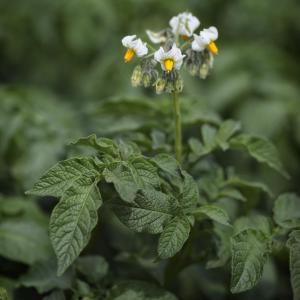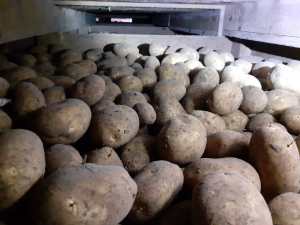Written by CPM Magazine from CPM Magazine
Download PDF
From the field to the store, potato sprout suppression strategies require attention to detail at every stage. CPM calls on one of the industry’s specialists to discuss tuber management techniques and the product options currently available.
By Janine Adamson

High growing season temperatures impact tuber formation and can cause secondary growth and premature sprouting.
Many feared life after CIPC, but the message is, with careful management, it’s possible to store a quality potato crop for a good duration of time. However, whether growers choose to achieve sprout suppression through treatment in-field, in-store, or both, has implications.
Industry specialist Geoff Hailstone is based in East Lothian and is UPL’s potato lead. He discusses the nuances of keeping sprouting at bay, the role of essential oils, and some of the additional benefits from opting to tackle the problem in-field.
What influences dormancy break and how do varieties vary?
Dormancy is a complex balance between genetic background, tuber development, plus environmental and management conditions during growth and storage. It’s established during tuber formation, with influencing factors including day length, temperature, nutrient and water supply.
For example, research has shown that potatoes cultivated during shorter days also have a shorter dormancy period. As for a high growing season temperature, this not only impacts tuber formation, but can also cause secondary growth and premature sprouting. Hot and dry conditions were a particular challenge during 2022, with some tubers entering storage having already sprouted in-field, or sprouting quickly once in-store.
It’s important to understand that dormancy break occurs before the visual sign of sprout development.
Temperature is also critical once a crop is being stored. Potatoes stored at lower temperatures tend to have a longer dormancy period compared with those kept at warmer temperatures.
Due to genetic variance, some varieties are more prone to sprouting than others – Desiree and Russett Burbank are known for their long-term store-ability. To investigate further, AHDB conducted work to develop a dormancy ranking system, storing and assessing key varieties at the former Sutton Bridge Crop Storage Research facility.
This work is important because it provides growers with a guide to understanding how each variety may perform once in-store, ideally housing tubers with similar dormancy lengths together to improve management efficiency.
How does maleic hydrazide help?
Maleic hydrazide, ‘MH’ is a plant growth regulator used to suppress sprouting in potatoes and since the loss of chlorpropham (CIPC), it’s become an integral management tool. Unlike other sprout suppressants, MH is a foliar spray applied to the growing crop, translocated from the leaves to the tubers in the phloem.

Using maleic hydrazide requires careful attention which starts by ensuring the crop is actively growing and at the correct stage in its lifecycle, says Geoff Hailstone.
The active ingredient is systemic, providing long periods of sprout suppression so is particularly useful for instances of long-term storage where an application of MH can be used alongside post-harvest treatments.
MH, which UPL markets as Fazor, is multi-faceted in its benefits. Not only does it reduce sprouting once tubers are in-store, it can also control secondary growth and volunteer potatoes. A benefit not always recognised is it’s been shown to inhibit internal sprouting, and is the only option available for this problem.
How do you get the best results?
Although effective in its mode of action, MH does require careful attention. This starts by ensuring that plants are actively growing and at the correct stage in their lifecycle, being the first signs of lower leaf senescence when most flowers have fallen. Importantly, stress, either heat or drought-related, should be avoided.
To help MH to translocate to the tubers, humid conditions are preferred which extend the period of absorption into the leaf. Growers may find applying later in the day or following irrigation will help to achieve this.
In terms of crop size, MH should be applied when saleable tubers are larger than 25mm as otherwise, the active ingredient can inhibit development and cause yield loss. The recommended water volume is between 350 and 550 l/ha to achieve optimum crop coverage. But to that end, avoid the temptation to tank mix because MH has to be applied on its own.
This all means achieving the correct timing can be difficult, particularly when juggling blight spray programmes and irrigation. However, where ideal application conditions can’t be met, there’s still value to be had in applying maleic hydrazide to achieve a useful level of in-store sprout suppression.
What about management in-store?
Good store hygiene and etiquette are critical to maintaining tuber quality including temperature and respiration management, both of which are reliant on adequate air circulation. Poor ventilation can lead to uneven temperatures and condensation which has an impact on marketable yield.
This can be influenced by box stacking, so it’s important to carefully design the arrangement of the store. It’s key to ensure box stacks are the same height with no obstructions to air flow as well as avoiding overfilling the store.
Whereas a few years ago in-store sprout suppression options were very limited, UK growers can now use dimethylnaphthalene (DMN), which was given full approval for use last year. For those unable to apply MH in-field at all, this provides an effective back-up.
Two essential oils are also available – spearmint and orange. UPL’s Argos is a natural product containing pure orange oil which is applied in-store as a hot fog. Argos has been available since autumn 2021, offering up to nine applications per crop.
Spearmint oil contains active substance r-carvone and although it can be applied in different ways, applications in the UK tend to be as a hot fog.

Orange oil works by physically damaging growing sprouts on contact, drying and disrupting the soft tissue.
How does orange oil work?
Like MH, orange oil is classed as a PGR. But how it differs is it works by physically damaging the growing sprouts on contact, drying and disrupting the soft tissue. The sprouts then fully desiccate and drop off, with control achieved for several weeks. Orange oil can then be reapplied after 21 days but the average period between applications is five weeks.
This mode of action is particularly useful for small sprouts less than 1mm in size when affecting no more than 20-25% of the stored crop. Regular in-store inspections with a hand lens can ensure this optimum timing is met. Ultimately, the earlier the sprouting is identified, the better.
However, only stores equipped with ventilation systems where the air is circulated through the potatoes are suitable for orange oil. This is because of the contact action of the product.
What are its advantages?
Orange oil’s greatest advantage is it’s very flexible – it can be used in both box and bulk situations in all varieties for chipping, crisping and fresh markets.
Because it’s extracted from orange peel with no chemical solvents or additives, it has an excellent sustainability profile and no MRL. It’s also suitable for use alongside other sprout suppressant chemistry such as MH.
Unlike DMN, there’s no waiting period (pre-harvest interval/PHI) so tubers can be delivered shortly after application, meaning growers can react quickly to market demands. And whereas DMN is applied preventatively, which can sometimes waste a potato’s natural dormancy, you don’t apply orange oil until you’ve identified initial sprouting.
In terms of useability, the orange oil fog is light and dry and when applied in optimum conditions, reaching all parts of the store. The vapour disappears within a few days and produces no taint on the treated potatoes or store itself.
Orange oil a great partner for MH and the two can be used together as part of a integrated approach to potato sprout suppression.
This article was taken from the latest issue of CPM. Read the article in full here.
For more articles like this, subscribe here.
Sign up for Crop Production Magazine’s FREE e-newsletter here.
The post Tech Talk: All is not lost appeared first on cpm magazine.
Continue reading on CPM website...
If you are enjoying what you read then why not considering subscribing here: http://www.cpm-magazine.co.uk/subscribe/
Download PDF
From the field to the store, potato sprout suppression strategies require attention to detail at every stage. CPM calls on one of the industry’s specialists to discuss tuber management techniques and the product options currently available.
“Ultimately, the earlier sprouting is identified, the better.”
By Janine Adamson

High growing season temperatures impact tuber formation and can cause secondary growth and premature sprouting.
Many feared life after CIPC, but the message is, with careful management, it’s possible to store a quality potato crop for a good duration of time. However, whether growers choose to achieve sprout suppression through treatment in-field, in-store, or both, has implications.
Industry specialist Geoff Hailstone is based in East Lothian and is UPL’s potato lead. He discusses the nuances of keeping sprouting at bay, the role of essential oils, and some of the additional benefits from opting to tackle the problem in-field.
What influences dormancy break and how do varieties vary?
Dormancy is a complex balance between genetic background, tuber development, plus environmental and management conditions during growth and storage. It’s established during tuber formation, with influencing factors including day length, temperature, nutrient and water supply.
For example, research has shown that potatoes cultivated during shorter days also have a shorter dormancy period. As for a high growing season temperature, this not only impacts tuber formation, but can also cause secondary growth and premature sprouting. Hot and dry conditions were a particular challenge during 2022, with some tubers entering storage having already sprouted in-field, or sprouting quickly once in-store.
It’s important to understand that dormancy break occurs before the visual sign of sprout development.
Temperature is also critical once a crop is being stored. Potatoes stored at lower temperatures tend to have a longer dormancy period compared with those kept at warmer temperatures.
Due to genetic variance, some varieties are more prone to sprouting than others – Desiree and Russett Burbank are known for their long-term store-ability. To investigate further, AHDB conducted work to develop a dormancy ranking system, storing and assessing key varieties at the former Sutton Bridge Crop Storage Research facility.
This work is important because it provides growers with a guide to understanding how each variety may perform once in-store, ideally housing tubers with similar dormancy lengths together to improve management efficiency.
How does maleic hydrazide help?
Maleic hydrazide, ‘MH’ is a plant growth regulator used to suppress sprouting in potatoes and since the loss of chlorpropham (CIPC), it’s become an integral management tool. Unlike other sprout suppressants, MH is a foliar spray applied to the growing crop, translocated from the leaves to the tubers in the phloem.

Using maleic hydrazide requires careful attention which starts by ensuring the crop is actively growing and at the correct stage in its lifecycle, says Geoff Hailstone.
The active ingredient is systemic, providing long periods of sprout suppression so is particularly useful for instances of long-term storage where an application of MH can be used alongside post-harvest treatments.
MH, which UPL markets as Fazor, is multi-faceted in its benefits. Not only does it reduce sprouting once tubers are in-store, it can also control secondary growth and volunteer potatoes. A benefit not always recognised is it’s been shown to inhibit internal sprouting, and is the only option available for this problem.
How do you get the best results?
Although effective in its mode of action, MH does require careful attention. This starts by ensuring that plants are actively growing and at the correct stage in their lifecycle, being the first signs of lower leaf senescence when most flowers have fallen. Importantly, stress, either heat or drought-related, should be avoided.
To help MH to translocate to the tubers, humid conditions are preferred which extend the period of absorption into the leaf. Growers may find applying later in the day or following irrigation will help to achieve this.
In terms of crop size, MH should be applied when saleable tubers are larger than 25mm as otherwise, the active ingredient can inhibit development and cause yield loss. The recommended water volume is between 350 and 550 l/ha to achieve optimum crop coverage. But to that end, avoid the temptation to tank mix because MH has to be applied on its own.
This all means achieving the correct timing can be difficult, particularly when juggling blight spray programmes and irrigation. However, where ideal application conditions can’t be met, there’s still value to be had in applying maleic hydrazide to achieve a useful level of in-store sprout suppression.
What about management in-store?
Good store hygiene and etiquette are critical to maintaining tuber quality including temperature and respiration management, both of which are reliant on adequate air circulation. Poor ventilation can lead to uneven temperatures and condensation which has an impact on marketable yield.
This can be influenced by box stacking, so it’s important to carefully design the arrangement of the store. It’s key to ensure box stacks are the same height with no obstructions to air flow as well as avoiding overfilling the store.
Whereas a few years ago in-store sprout suppression options were very limited, UK growers can now use dimethylnaphthalene (DMN), which was given full approval for use last year. For those unable to apply MH in-field at all, this provides an effective back-up.
Two essential oils are also available – spearmint and orange. UPL’s Argos is a natural product containing pure orange oil which is applied in-store as a hot fog. Argos has been available since autumn 2021, offering up to nine applications per crop.
Spearmint oil contains active substance r-carvone and although it can be applied in different ways, applications in the UK tend to be as a hot fog.

Orange oil works by physically damaging growing sprouts on contact, drying and disrupting the soft tissue.
How does orange oil work?
Like MH, orange oil is classed as a PGR. But how it differs is it works by physically damaging the growing sprouts on contact, drying and disrupting the soft tissue. The sprouts then fully desiccate and drop off, with control achieved for several weeks. Orange oil can then be reapplied after 21 days but the average period between applications is five weeks.
This mode of action is particularly useful for small sprouts less than 1mm in size when affecting no more than 20-25% of the stored crop. Regular in-store inspections with a hand lens can ensure this optimum timing is met. Ultimately, the earlier the sprouting is identified, the better.
However, only stores equipped with ventilation systems where the air is circulated through the potatoes are suitable for orange oil. This is because of the contact action of the product.
What are its advantages?
Orange oil’s greatest advantage is it’s very flexible – it can be used in both box and bulk situations in all varieties for chipping, crisping and fresh markets.
Because it’s extracted from orange peel with no chemical solvents or additives, it has an excellent sustainability profile and no MRL. It’s also suitable for use alongside other sprout suppressant chemistry such as MH.
Unlike DMN, there’s no waiting period (pre-harvest interval/PHI) so tubers can be delivered shortly after application, meaning growers can react quickly to market demands. And whereas DMN is applied preventatively, which can sometimes waste a potato’s natural dormancy, you don’t apply orange oil until you’ve identified initial sprouting.
In terms of useability, the orange oil fog is light and dry and when applied in optimum conditions, reaching all parts of the store. The vapour disappears within a few days and produces no taint on the treated potatoes or store itself.
Orange oil a great partner for MH and the two can be used together as part of a integrated approach to potato sprout suppression.
This article was taken from the latest issue of CPM. Read the article in full here.
For more articles like this, subscribe here.
Sign up for Crop Production Magazine’s FREE e-newsletter here.
The post Tech Talk: All is not lost appeared first on cpm magazine.
Continue reading on CPM website...
If you are enjoying what you read then why not considering subscribing here: http://www.cpm-magazine.co.uk/subscribe/





